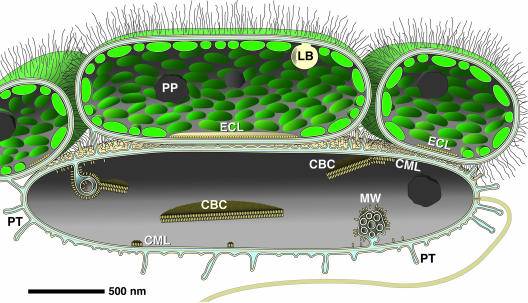FIG. 6.
Schematic representation according to 3D reconstruction data for “Chlorochromatium aggregatum” summarizes the results of this study. Epibionts are connected by long, hair-like polysaccharide chains. The epibionts harbor lipid bodies (LB) with a myelin-like pattern which are attached to the cytoplasmic membrane and polyphosphate globules (PP). The attachment site of the epibiont is characterized by the absence of chlorosomes and a single contact layer (ECL, epibiont contact layer). Striking features of the flagellated central bacterium are (i) periplasmic tubules (PT), which can be in direct contact with the epibionts, postulated to form a common periplasmic space; (ii) complex invaginations (MW, membranous whirls) of the cytoplasmic membrane; (iii) subunits arranged in small monolayers or bilayers directly associated with the cytoplasmic membrane (CML, central bacterium membrane layer); and (iv) paracrystalline structures (CBC, central bacterium crystals) which are formed on the inner side of the cytoplasmic membrane (or membranous invaginations) by the accumulation of subunits. Globular structures occur in the cytoplasm of the central bacterium.

